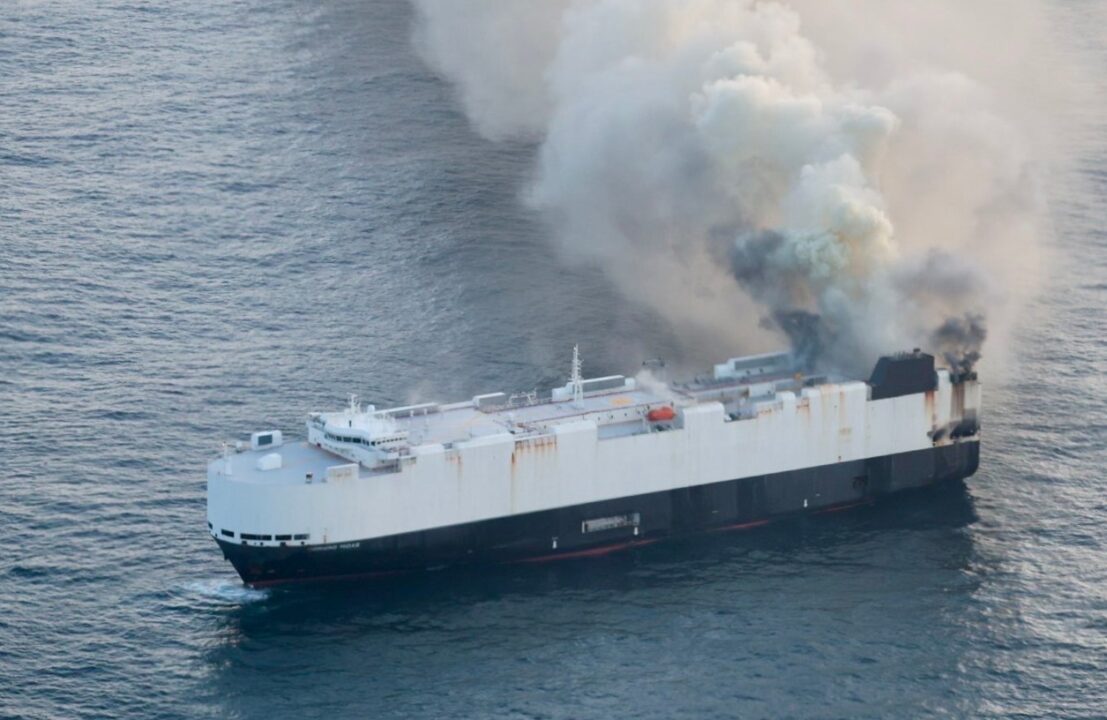The cargo vessel has now been abandoned. And while no cause has been officially assigned, the lithium batteries are the prime suspect.
Photographs show the vessel still smoking hundreds of miles from the nearest coastline days after the initial distress signal was received. Thick columns of smoke can be seen billowing into the sky.
Incredibly, all 22 crew members were safely evacuated onto a lifeboat on Tuesday afternoon and later rescued by a nearby merchant vessel.
They remained aboard the rescue ship as of Thursday, the vessel’s management company, London-based Zodiac Maritime, said.
…The cause of the fire remains under investigation but lithium-ion batteries, widely used in electric vehicles, are known to present firefighting challenges due to their high combustibility once ignited.
Salvage crews are on their way.
A salvage team is expected to arrive early next week at the scene of a cargo ship that was carrying about 3,000 vehicles to Mexico when it caught fire in waters off Alaska’s Aleutian island chain.
A tug carrying salvage specialists and special equipment is expected to arrive at the location of the Morning Midas around Monday, the ship’s management company, London-based Zodiac Maritime, said Thursday. The crew will assess the ship’s condition, and a separate tug with firefighting and ocean towage capabilities is being arranged, the company said in its statement. In the meantime, officials are using the ship’s onboard satellite-connected systems to monitor it.
Originally published date – June 8th
A 600-foot cargo ship named the Morning Midas, which left China loaded with 3,048 vehicles, has been burning at sea since June 4th. Today would be day five (the last update was two days ago).
Alaska Coast Guard reports that the crew was safely evacuated after a fire started and spread, the point of ignition (IMO) likely being one of the 70 fully electric vehicles onboard.
Its current position is 340 miles southwest of Adak (pin drop on map), Alaska (pop 171).

Emissions
EV car fires aren’t as toxic as battery backup storage facilities (which have a habit of igniting), but they are bad. Obscene amounts of dangerous gases and particulates drift into the atmosphere and the local biosphere, poisoning it with heavy metals. Now ass in the other vehicles, all their plastic, rubber, electronics, and other bits, and the ship itself.
That’s a lot of emissions. How do we mitigate them (assuming you’re the misinformed sort that believe that is the point of EVs)?
No car fire is good when it comes to the smoke and fumes, but internal combustion engine vehicles (ICE) can be extinguished in short order, while EVs must be left to burn – controlling the spread is about the only thing that can be done. [Related: The Emissionary Position. If You Really Want to Lower “Global Emissions,” …]
After checking a few bits of research on car fire “emissions,” I’ve not seen any serious consideration of this fact. EVs will emit hydrogen fluoride while ICEs release more lead. But if a fire burns 20 minutes or several hours, it seems that all the other stuff burning, which they have in common, is producing more airborne pollutants.
Then we’ve got over 3000 vehicles on a container ship burning for days.
The verdict on the point of ignitian will remain unclear until the fire goes out and they can look but give the number of these from busses to fire trucks to car fires on Ferries, many of which no ban them, my money os on the EV as the starting point and, given the runaway nature of such fires, the reason it got so hot and spread making it impossible to do anything but evacuate and watch.
